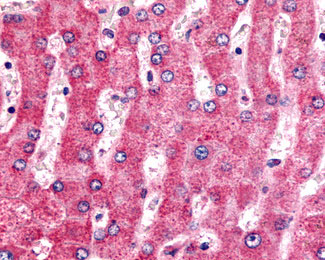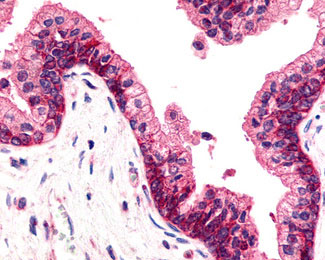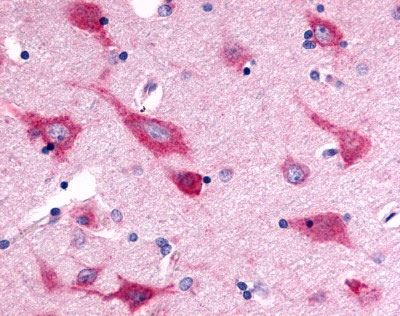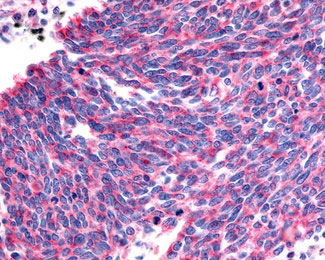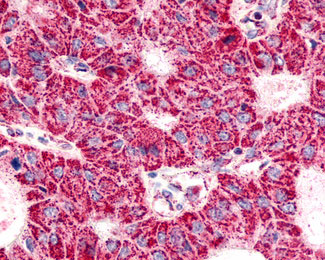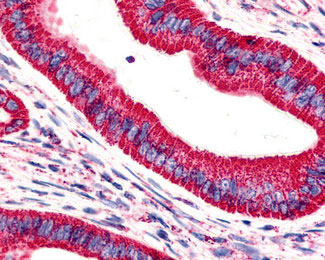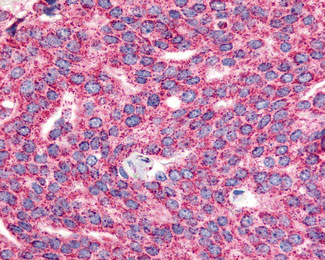ADGRG6 / GPR126 Antibody (C-Terminus)
Rabbit Polyclonal Antibody
- SPECIFICATION
- CITATIONS
- PROTOCOLS
- BACKGROUND

Application
| IHC-P |
|---|---|
| Primary Accession | Q86SQ4 |
| Reactivity | Human |
| Host | Rabbit |
| Clonality | Polyclonal |
| Calculated MW | 137kDa |
| Dilution | IHC-P (3-5 µg/ml) |
| Gene ID | 57211 |
|---|---|
| Other Names | G-protein coupled receptor 126, Developmentally regulated G-protein-coupled receptor, Vascular inducible G protein-coupled receptor, GPR126, DREG, VIGR |
| Target/Specificity | Human GPR126. BLAST analysis of the peptide immunogen showed no homology with other human proteins. |
| Reconstitution & Storage | Long term: -70°C; Short term: +4°C |
| Precautions | ADGRG6 / GPR126 Antibody (C-Terminus) is for research use only and not for use in diagnostic or therapeutic procedures. |
| Name | ADGRG6 (HGNC:13841) |
|---|---|
| Function | Adhesion G-protein coupled receptor (aGPCR) for steroid hormones, such as progesterone and 17alpha-hydroxyprogesterone (17OHP) (PubMed:35394864, PubMed:39884271). Involved in many biological processes, such as myelination, sprouting angiogenesis, placenta, ear and cartilage development (By similarity). Ligand binding causes a conformation change that triggers signaling via guanine nucleotide- binding proteins (G proteins) and modulates the activity of downstream effectors, such as adenylate cyclase (PubMed:24227709, PubMed:35394864). ADGRG6 is coupled to G(i) G alpha proteins and mediates inhibition of adenylate cyclase (PubMed:24227709, PubMed:35394864). Also able to couple to G(q) G proteins (PubMed:24227709). Involved in myelination of the peripheral nervous system: required for differentiation of promyelinating Schwann cells and for normal myelination of axons (PubMed:24227709). Also acts as a regulator of body length and bone mass (PubMed:18391950). Acts as a regulator of blood-brain barrier formation in the central nervous system vie its association with LRP1 and ITGB1 (By similarity). |
| Cellular Location | Cell membrane; Multi-pass membrane protein. Note=Detected on the cell surface of activated but not resting umbilical vein. |
| Tissue Location | Expressed in placenta and to a lower extent in pancreas and liver. Detected in aortic endothelial cells but not in skin microvascular endothelial cells. |
| Volume | 50 µl |

Thousands of laboratories across the world have published research that depended on the performance of antibodies from Abcepta to advance their research. Check out links to articles that cite our products in major peer-reviewed journals, organized by research category.
info@abcepta.com, and receive a free "I Love Antibodies" mug.
Provided below are standard protocols that you may find useful for product applications.
Background
Orphan receptor. May be required for normal differentiation of promyelinating Schwann cells and for normal myelination of axons. Signals probably through G-proteins to transiently elevate cAMP levels (By similarity).
References
Stehlik C.,et al.FEBS Lett. 569:149-155(2004).
Moriguchi T.,et al.Genes Cells 9:549-560(2004).
Bechtel S.,et al.BMC Genomics 8:399-399(2007).
Mungall A.J.,et al.Nature 425:805-811(2003).
Ota T.,et al.Nat. Genet. 36:40-45(2004).
If you have used an Abcepta product and would like to share how it has performed, please click on the "Submit Review" button and provide the requested information. Our staff will examine and post your review and contact you if needed.
If you have any additional inquiries please email technical services at tech@abcepta.com.













 Foundational characteristics of cancer include proliferation, angiogenesis, migration, evasion of apoptosis, and cellular immortality. Find key markers for these cellular processes and antibodies to detect them.
Foundational characteristics of cancer include proliferation, angiogenesis, migration, evasion of apoptosis, and cellular immortality. Find key markers for these cellular processes and antibodies to detect them. The SUMOplot™ Analysis Program predicts and scores sumoylation sites in your protein. SUMOylation is a post-translational modification involved in various cellular processes, such as nuclear-cytosolic transport, transcriptional regulation, apoptosis, protein stability, response to stress, and progression through the cell cycle.
The SUMOplot™ Analysis Program predicts and scores sumoylation sites in your protein. SUMOylation is a post-translational modification involved in various cellular processes, such as nuclear-cytosolic transport, transcriptional regulation, apoptosis, protein stability, response to stress, and progression through the cell cycle. The Autophagy Receptor Motif Plotter predicts and scores autophagy receptor binding sites in your protein. Identifying proteins connected to this pathway is critical to understanding the role of autophagy in physiological as well as pathological processes such as development, differentiation, neurodegenerative diseases, stress, infection, and cancer.
The Autophagy Receptor Motif Plotter predicts and scores autophagy receptor binding sites in your protein. Identifying proteins connected to this pathway is critical to understanding the role of autophagy in physiological as well as pathological processes such as development, differentiation, neurodegenerative diseases, stress, infection, and cancer.
